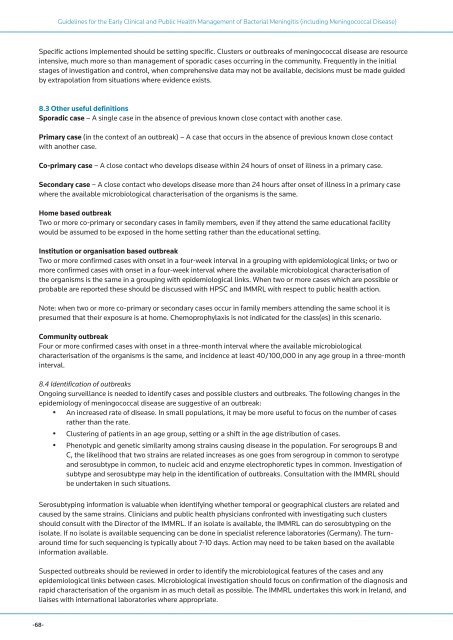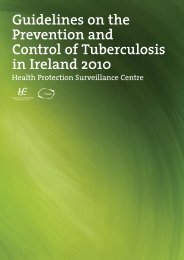Guidelines for the Early Clinical and Public Health Management of ...
Guidelines for the Early Clinical and Public Health Management of ...
Guidelines for the Early Clinical and Public Health Management of ...
Create successful ePaper yourself
Turn your PDF publications into a flip-book with our unique Google optimized e-Paper software.
<strong>Guidelines</strong> <strong>for</strong> <strong>the</strong> <strong>Early</strong> <strong>Clinical</strong> <strong>and</strong> <strong>Public</strong> <strong>Health</strong> <strong>Management</strong> <strong>of</strong> Bacterial Meningitis (including Meningococcal Disease)<br />
Specific actions implemented should be setting specific. Clusters or outbreaks <strong>of</strong> meningococcal disease are resource<br />
intensive, much more so than management <strong>of</strong> sporadic cases occurring in <strong>the</strong> community. Frequently in <strong>the</strong> initial<br />
stages <strong>of</strong> investigation <strong>and</strong> control, when comprehensive data may not be available, decisions must be made guided<br />
by extrapolation from situations where evidence exists.<br />
8.3 O<strong>the</strong>r useful definitions<br />
Sporadic case – A single case in <strong>the</strong> absence <strong>of</strong> previous known close contact with ano<strong>the</strong>r case.<br />
Primary case (in <strong>the</strong> context <strong>of</strong> an outbreak) – A case that occurs in <strong>the</strong> absence <strong>of</strong> previous known close contact<br />
with ano<strong>the</strong>r case.<br />
Co-primary case – A close contact who develops disease within 24 hours <strong>of</strong> onset <strong>of</strong> illness in a primary case.<br />
Secondary case – A close contact who develops disease more than 24 hours after onset <strong>of</strong> illness in a primary case<br />
where <strong>the</strong> available microbiological characterisation <strong>of</strong> <strong>the</strong> organisms is <strong>the</strong> same.<br />
Home based outbreak<br />
Two or more co-primary or secondary cases in family members, even if <strong>the</strong>y attend <strong>the</strong> same educational facility<br />
would be assumed to be exposed in <strong>the</strong> home setting ra<strong>the</strong>r than <strong>the</strong> educational setting.<br />
Institution or organisation based outbreak<br />
Two or more confirmed cases with onset in a four-week interval in a grouping with epidemiological links; or two or<br />
more confirmed cases with onset in a four-week interval where <strong>the</strong> available microbiological characterisation <strong>of</strong><br />
<strong>the</strong> organisms is <strong>the</strong> same in a grouping with epidemiological links. When two or more cases which are possible or<br />
probable are reported <strong>the</strong>se should be discussed with HPSC <strong>and</strong> IMMRL with respect to public health action.<br />
Note: when two or more co-primary or secondary cases occur in family members attending <strong>the</strong> same school it is<br />
presumed that <strong>the</strong>ir exposure is at home. Chemoprophylaxis is not indicated <strong>for</strong> <strong>the</strong> class(es) in this scenario.<br />
Community outbreak<br />
Four or more confirmed cases with onset in a three-month interval where <strong>the</strong> available microbiological<br />
characterisation <strong>of</strong> <strong>the</strong> organisms is <strong>the</strong> same, <strong>and</strong> incidence at least 40/100,000 in any age group in a three-month<br />
interval.<br />
8.4 Identification <strong>of</strong> outbreaks<br />
Ongoing surveillance is needed to identify cases <strong>and</strong> possible clusters <strong>and</strong> outbreaks. The following changes in <strong>the</strong><br />
epidemiology <strong>of</strong> meningococcal disease are suggestive <strong>of</strong> an outbreak:<br />
• An increased rate <strong>of</strong> disease. In small populations, it may be more useful to focus on <strong>the</strong> number <strong>of</strong> cases<br />
ra<strong>the</strong>r than <strong>the</strong> rate.<br />
• Clustering <strong>of</strong> patients in an age group, setting or a shift in <strong>the</strong> age distribution <strong>of</strong> cases.<br />
• Phenotypic <strong>and</strong> genetic similarity among strains causing disease in <strong>the</strong> population. For serogroups B <strong>and</strong><br />
C, <strong>the</strong> likelihood that two strains are related increases as one goes from serogroup in common to serotype<br />
<strong>and</strong> serosubtype in common, to nucleic acid <strong>and</strong> enzyme electrophoretic types in common. Investigation <strong>of</strong><br />
subtype <strong>and</strong> serosubtype may help in <strong>the</strong> identification <strong>of</strong> outbreaks. Consultation with <strong>the</strong> IMMRL should<br />
be undertaken in such situations.<br />
Serosubtyping in<strong>for</strong>mation is valuable when identifying whe<strong>the</strong>r temporal or geographical clusters are related <strong>and</strong><br />
caused by <strong>the</strong> same strains. Clinicians <strong>and</strong> public health physicians confronted with investigating such clusters<br />
should consult with <strong>the</strong> Director <strong>of</strong> <strong>the</strong> IMMRL. If an isolate is available, <strong>the</strong> IMMRL can do serosubtyping on <strong>the</strong><br />
isolate. If no isolate is available sequencing can be done in specialist reference laboratories (Germany). The turnaround<br />
time <strong>for</strong> such sequencing is typically about 7-10 days. Action may need to be taken based on <strong>the</strong> available<br />
in<strong>for</strong>mation available.<br />
Suspected outbreaks should be reviewed in order to identify <strong>the</strong> microbiological features <strong>of</strong> <strong>the</strong> cases <strong>and</strong> any<br />
epidemiological links between cases. Microbiological investigation should focus on confirmation <strong>of</strong> <strong>the</strong> diagnosis <strong>and</strong><br />
rapid characterisation <strong>of</strong> <strong>the</strong> organism in as much detail as possible. The IMMRL undertakes this work in Irel<strong>and</strong>, <strong>and</strong><br />
liaises with international laboratories where appropriate.<br />
-68-

















